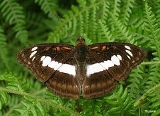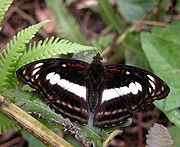
Athyma selenophora
Encyclopedia
The Staff Sergeant is a species of nymphalid
butterfly found in tropical and subtropical Asia
.

 Male Upperside- black- Forewing: discoidal streak deep red, twice divided, the apical portion dusky white; three elongate oval white spots in the interspaces beyond; a distinct white band, variable in width, from dorsum to interspace 3; an obscure inner subterminal line of transverse whitish marks, and a still more obscure outer sub terminal pale line. Hind wing with the broad white discal band of the fore wing continued across to vein 1, a postdiscal narrow diffuse pale macular band, and a subterminal pale line; abdominal fold dusky grey ; cilia of both fore and hind wings black, alternated with white. Underside bright chestnut-red; the markings as on the upperside but all white, on the terminal portions of the wings diffuse; discoidal streak in fore wing white, diffuse, more broadly divided ; interspace 8 white at base, with a dark chestnut-red loop below it in interspace 7 crossing into the cellular area; very dark postdiscal blotches in interspaces 1a, 1 to 3 on fore wing; and a series of very dark chestnut-red marks between discal and postdiseal bands on the hind wing; dorsal margin of hind wing broadly blue, Antennae, head, thorax and abdomen very dark brown ; beneath, the palpi, thorax and abdomen white faintly tinged with blue.
Male Upperside- black- Forewing: discoidal streak deep red, twice divided, the apical portion dusky white; three elongate oval white spots in the interspaces beyond; a distinct white band, variable in width, from dorsum to interspace 3; an obscure inner subterminal line of transverse whitish marks, and a still more obscure outer sub terminal pale line. Hind wing with the broad white discal band of the fore wing continued across to vein 1, a postdiscal narrow diffuse pale macular band, and a subterminal pale line; abdominal fold dusky grey ; cilia of both fore and hind wings black, alternated with white. Underside bright chestnut-red; the markings as on the upperside but all white, on the terminal portions of the wings diffuse; discoidal streak in fore wing white, diffuse, more broadly divided ; interspace 8 white at base, with a dark chestnut-red loop below it in interspace 7 crossing into the cellular area; very dark postdiscal blotches in interspaces 1a, 1 to 3 on fore wing; and a series of very dark chestnut-red marks between discal and postdiseal bands on the hind wing; dorsal margin of hind wing broadly blue, Antennae, head, thorax and abdomen very dark brown ; beneath, the palpi, thorax and abdomen white faintly tinged with blue.
Female Upperside velvety brownish black with white and pale markings, Fore wing : the discoidal streak clavate, twice divided, a large elongate triangular spot beyond apex of cell; a macular discal band of four large spots inclined outwards from dorsum, and three obliquely placed spots from beyond the middle of the costa, the lowest spot of these minute, the next two large, elongate, with a very slender short streak above them on the costa; an inner subterminal series of transverse spots and an outer subterminal pale incomplete line. Hind wing ; the subbasal broad band widening towards costa; a postdiscal series of large, inwardly bluntly conical spots and a broad subterminal pale line- Underside as in the male, but the white markings broader, the ground-colour not so bright. Antennae, thorax and abdomen as in the male but the abdomen with a white transverse band at base.
Expanse: 66–72 mm
Habitat: The Himalayas; Southern India, the Nilgiris
, the Western Ghats
; Assam
, Myanmar
and northern Tenasserim.
In the dry-season form the ground-colour in both sexes is brown, paler in the male than in the female; the discal band variable in width, but on the whole broader both on the upper and under sides, and the ground-colour on the underside ochraceous brown.
Larva and pupa: Like that of Athyma inara, Doubleday & Hewitson, but the dorsal patch is much smaller and there are some white spots on the sides. The pupa is distinguished from that of A. inara by slight differences in the shape of the grotesque processes on the head and thorax. The common food-plant is the Adina cordifolia
(Davidson, Bell and Aitken)
Nymphalidae
The Nymphalidae is a family of about 5,000 species of butterflies which are distributed throughout most of the world. These are usually medium sized to large butterflies. Most species have a reduced pair of forelegs and many hold their colourful wings flat when resting. They are also called...
butterfly found in tropical and subtropical Asia
Asia
Asia is the world's largest and most populous continent, located primarily in the eastern and northern hemispheres. It covers 8.7% of the Earth's total surface area and with approximately 3.879 billion people, it hosts 60% of the world's current human population...
.
Description


Female Upperside velvety brownish black with white and pale markings, Fore wing : the discoidal streak clavate, twice divided, a large elongate triangular spot beyond apex of cell; a macular discal band of four large spots inclined outwards from dorsum, and three obliquely placed spots from beyond the middle of the costa, the lowest spot of these minute, the next two large, elongate, with a very slender short streak above them on the costa; an inner subterminal series of transverse spots and an outer subterminal pale incomplete line. Hind wing ; the subbasal broad band widening towards costa; a postdiscal series of large, inwardly bluntly conical spots and a broad subterminal pale line- Underside as in the male, but the white markings broader, the ground-colour not so bright. Antennae, thorax and abdomen as in the male but the abdomen with a white transverse band at base.
Expanse: 66–72 mm
Habitat: The Himalayas; Southern India, the Nilgiris
Nilgiris (mountains)
The Nilgiri , often referred to as the Nilgiri Hills, are a range of mountains with at least 24 peaks above , in the westernmost part of Tamil Nadu state at the junction of Karnataka and Kerala states in Southern India...
, the Western Ghats
Western Ghats
The Western Ghats, Western Ghauts or the Sahyādri is a mountain range along the western side of India. It runs north to south along the western edge of the Deccan Plateau, and separates the plateau from a narrow coastal plain along the Arabian Sea. The Western Ghats block rainfall to the Deccan...
; Assam
Assam
Assam , also, rarely, Assam Valley and formerly the Assam Province , is a northeastern state of India and is one of the most culturally and geographically distinct regions of the country...
, Myanmar
Myanmar
Burma , officially the Republic of the Union of Myanmar , is a country in Southeast Asia. Burma is bordered by China on the northeast, Laos on the east, Thailand on the southeast, Bangladesh on the west, India on the northwest, the Bay of Bengal to the southwest, and the Andaman Sea on the south....
and northern Tenasserim.
In the dry-season form the ground-colour in both sexes is brown, paler in the male than in the female; the discal band variable in width, but on the whole broader both on the upper and under sides, and the ground-colour on the underside ochraceous brown.
Larva and pupa: Like that of Athyma inara, Doubleday & Hewitson, but the dorsal patch is much smaller and there are some white spots on the sides. The pupa is distinguished from that of A. inara by slight differences in the shape of the grotesque processes on the head and thorax. The common food-plant is the Adina cordifolia
Adina Cordifolia
Haldina cordifolia, syn. Adina cordifolia, also known as Kadam or Kadamba in Hindi, is a flowering plant in the family Rubiaceae, the sole species in the genus Haldina. It is native to southern Asia, from India and Sri Lanka east to southern China and Vietnam.It is a deciduous tree that can grow...
(Davidson, Bell and Aitken)

